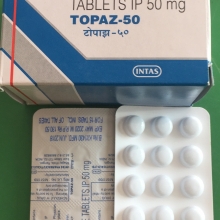Home / Categories / TOPAZ-50MG

TOPAZ-50MG
(10S*15T)
TOPIRAMATE-50MG
ANTI-CONVULSANTS
INTAS PHARMACEUTICAL-ALECTA-DIVISION
Product Details
Topiramate
A to Z Drug Facts
| Topiramate |
| (Toe-PEER-ah-mate) |
| Topamax |
| Tablets: 25 mg, 100 mg, 200 mg |
| Capsules, sprinkle: 15 mg, 25 mg |
| Class: Anticonvulsant |
 Actions Precise mechanism is unknown but topiramate may: block repetitively elicited action potentials; affect ability of chloride ion to move into neurosis; and antagonize an excitatory amino acid receptor.
Actions Precise mechanism is unknown but topiramate may: block repetitively elicited action potentials; affect ability of chloride ion to move into neurosis; and antagonize an excitatory amino acid receptor.
 Indications Adjunctive therapy for partial onset seizures; primary generalized tonic-clonic seizures; seizures associated with Lennox-Gastaut syndrome.
Indications Adjunctive therapy for partial onset seizures; primary generalized tonic-clonic seizures; seizures associated with Lennox-Gastaut syndrome.
 Contraindications Standard considerations.
Contraindications Standard considerations.
ADULTS (³ 17 yr): PO 400 mg daily in 2 divided doses. Initiate therapy at 25 to 50 mg/day and titrate to an effective dose in increments of 25 to 50 mg/wk. Doses > 400 mg have not been shown to improve response.
CHILDREN (2 to 16 yr): PO 5 to 9 mg/kg/day in 2 divided doses. Initiate therapy at £ 25 mg (based on range of 1 to 3 mg/kg/day) nightly for first week and titrate to an effective dose at 1- to 2-wk intervals by increments of 1 to 3 mg/kg/day in 2 divided doses.
Alcohol, CNS depressants: CNS depression and side effects may be increased. Carbamazepine: Effects of topiramate may be decreased. Carbonic anhydrase inhibitors (eg, acetazolamide): Increased risk of renal stone formation. Oral contraceptives: Efficacy of oral contraceptives may be decreased. Phenytoin: Effects of phenytoin may be increased while those of topiramate may decrease.
 Lab Test Interferences None well documented.
Lab Test Interferences None well documented.
CARDIOVASCULAR: Palpitations. CNS: Memory, concentration, and attention difficulty; fatigue; confusion; somnolence; depression; ataxia; dizziness; psychomotor slowing; nervousness; speech disorder/problems; language problems; mood problems; aggressive behavior; apathy; emotional lability; paresthesia; tremor; depersonalization; malaise; hypokinesia; vertigo; stupor; grand mal convulsions; hyperkinesia; hypothesia; hypertonia; insomnia; hallucinations; euphoria; psychosis; decreased libido; suicide attempt; incoordination. DERMATOLOGIC: Rash; pruritis; acne; alopecia. EENT: Nystagmus; diplopia; abnormal vision; eye pain; decreased hearing; tinnitus; epistaxis; conjunctivitis. GI: Nausea; vomiting; flatulence; gastroenteritis; dyspepsia; anorexia; abdominal pain; constipation; diarrhea; gingivitis; taste perversion. GU: Breast pain; dysmenorrhea; menstrual disorder; hematuria; menorrhagia; leukorrhea; amenorrhea; intermenstrual bleeding; vaginitis; urinary tract infection; micturition frequency; urinary incontinence; dysuria; renal calculus; impotence. HEMATOLOGIC: Leukopenia; anemia. METABOLIC: Weight gain; weight loss. RESPIRATORY: Pharyngitis; sinusitis; dyspnea; coughing; bronchitis. OTHER: Asthenia; back, leg, and chest pain; flu-like symptoms; hot flushes; fever; arthralgia; myalgia; muscle weakness; body odor; edema; rigors.
Pregnancy: Category C. Children: Safety and efficacy in children < 2 yr not established. Lactation: Undetermined. Elderly: No age-related differences in safety and efficacy have been seen, although consider age-related changes in renal function. Withdrawal: Gradually withdraw therapy to minimize potential of increased seizure frequency. Renal impairment: Reduce dose by 50% of Ccr < 70 mL/hr. Hemodialysis: Supplemental dose may be necessary before prolonged dialysis. Hepatic impairment: Administer with caution. Kidney stones: Risk of developing kidney stones may be increased. Acute myopia: Acute myopia secondary to angle closure glaucoma has been reported.
| PATIENT CARE CONSIDERATIONS |
|
- Available only in tablet form for oral administration.
- Store tablets at room temperature (59° to 86°F; 15° to 30°C).
- Store in tightly closed container; protect from moisture.
- May be taken with or without food.
- Do not crush, chew, or break tablet because of bitter taste.
- Obtain patient history, including drug history and any known allergies. Note hepatic, renal impairment.
- Before initiation of therapy, assess the patient for hepatic or renal disorders, hypotension, alcohol abuse, or porphyria.
- Assess type of seizure activity displayed, onset, and duration prior to the initiation of therapy.
- Monitor patient during therapy for effectiveness and side effects. Report seizure activity and side effects to health care provider.
- Advise patient that medication may be taken with or without food.
- Advise patient not to crush, break, or chew tablet.
- Advise patient not to discontinue or change dose unless advised to do so by health care provider.
- Advise patient that drug may cause drowsiness, dizziness, or blurred vision and to use caution while driving or performing other tasks requiring mental alertness until tolerance is determined.
- Caution patient to consult with health care provider before using alcohol or taking any other drug, including otc medications.
- Warn patient that stopping medication too quickly may precipitate seizures.
- Advise patient regarding adequate fluid intake (2 to 3 L/day) to minimize renal stone development.
- Warn patient not to stop taking other prescribed antiseizure medications; topiramate is used in conjunction with other medications.
- Stress the need to take the medication exactly as prescribed and not to skip or double up on missed doses.
- Advise patient to carry identification such as Medi-Alert that identifies medical condition and medication(s).
- Advise patient to report any suspected side effects to health care provider.
- Advise patient that effectiveness of oral contraceptives may be decreased and to consider use of an alternative method of contraception and to report any change in menstrual cycle.
Books@Ovid
Copyright © 2003 Facts and Comparisons
David S. Tatro
A to Z Drug Facts
-->
 Route/Dosage
Route/Dosage Interactions
Interactions Adverse Reactions
Adverse Reactions Precautions
Precautions Administration/Storage
Administration/Storage Assessment/Interventions
Assessment/Interventions Patient/Family Education
Patient/Family Education